Bus Speed and Reliability
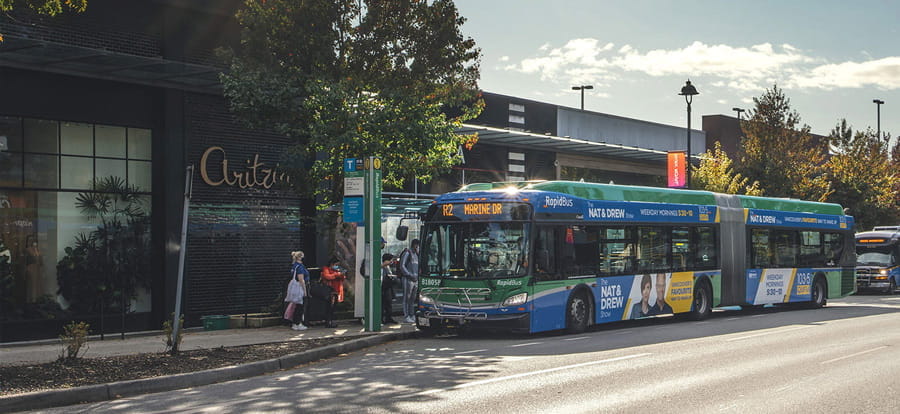
2023 Bus Speed & Reliability Report
TransLink’s Bus Speed & Reliability Report highlights the problem of bus delay. It studies the causes of delay and its impacts on both customers and operations – quantifying hotspots across the region. It also demonstrates how TransLink and our municipal partners have successfully reduced delays through significant investments in bus priority measures in recent years. Ultimately, the report supports and guides future investments to improve TransLink’s customer experience and operational efficiency.
Bus Delays
Buses carry more than 60% of transit customers in the region. When buses are slowed by traffic, it has a real impact on the lives of our customers. These delays also cost TransLink over $80 million per year simply to maintain bus frequencies.
Bus Priority Infrastructure & Gaps
TransLink has made significant investments in over 100 bus priority studies and projects in recent years, leading to a historic expansion of the bus priority network. These projects have improved customer travel times by up to 35% and can pay for themselves in just a few months as buses are used more efficiently.
The Bus Priority Vision
Our aim over the next decade is to improve bus speed and reliability along our busiest transit corridors. TransLink’s Bus Priority Vision aligns closely with the Access for Everyone plan, addressing the region's long-term transportation needs. It proposes practical measures to efficiently manage our streets for a variety of uses. Whether it’s commuting or accessing essential services, our vision for bus priority ensures efficient and sustainable travel for everyone.
2023 Bus Speed & Reliability Report – Bus Priority Vision
- Full Report with Appendices (high resolution)
For a more screen-reader-friendly and compressed version of the 2023 Bus Speed & Reliability report, please refer to the list of individual parts in PDF format below.
Reports and Appendices
- Report with Appendices – Part 1 – 1.5 MB
- Report with Appendices – Part 2 – 3.2 MB
- Report with Appendices – Part 3 – 9.9 MB
- Report with Appendices – Part 4 – 11.2 MB
- Report with Appendices – Part 5 – 1.5 MB
- Report with Appendices – Part 6 – 2.9 MB
- Appendix A – Sub-Regional Profiles – 8.4 MB
- Appendix B – Profile Areas – Part 1 – 2.3 MB
- Appendix B – Profile Areas – Part 2 – 6.2 MB
- Appendix B – Profile Areas – Part 3 – 5.9 MB
- Appendix B – Profile Areas – Part 4 – 5.5 MB
- Appendix B – Profile Areas – Part 5 – 5.4 MB
Bus Priority Projects
TransLink works closely with municipalities to identify opportunities to improve travel times, access, and the capacity of our roads to move more people. Learn more about these initiatives on our Bus Priority Projects page.
Transit Priority Toolkit
As a complement to the first Bus Speed and Reliability Report, TransLink created a Transit Priority Toolkit.
The Transit Priority Toolkit provides TransLink and municipal partners with specific ways to improve travel time and reliability of transit service ranging from new designs for streets and bus stops to strategies for managing curbs, traffic, and signals.
Both documents serve as guidance for TransLink and municipal partners to address region-wide bus speed and reliability for the more than 700,000 customers who ride the bus each day.
Transit Priority Measures
Small changes can make a big difference to your bus journey, especially along the region’s busiest corridors. That’s why, alongside larger-scale projects, we support the implementation of local, context-specific tools to improve your bus journey.
Bus Bulbs
Bus bulbs are sidewalk extensions that allow buses to serve customers from the travel lane. Bus bulbs improve travel time and reliability by eliminating delays caused by merging into and out of the travel lane at bus stops.
This priority measure protects buses from reliability issues in congested periods, saving buses and transit customers between 15 to 30 seconds per stop, resulting in a 7% increase in bus speeds. Bus bulbs also create more space for waiting, walking, and physical distancing.
Bus Islands
Like bus bulbs, bus islands create additional space for transit passengers and amenities. They allow buses to serve customers while keeping bike lanes or multi-use paths clear for people biking or walking.
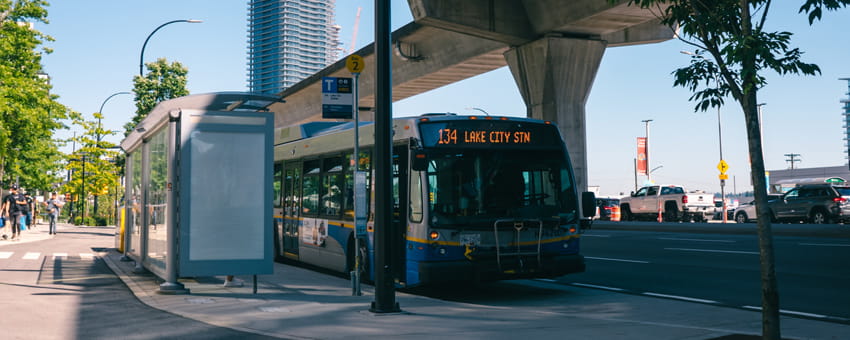 Bus Island at Brentwood Station
Bus Island at Brentwood Station
Bus Stop Optimizing
Bus stop optimizing (also called bus stop balancing) refers to the thoughtful removal and/or relocation of bus stops along a corridor to achieve more consistent spacing, maintain convenient access, and provide faster, more reliable service. See where we’ve implemented bus stop optimization across the region.
Bus Lanes / BAT Lanes
Bus lanes are traffic lanes that are reserved for buses and marked by signage or paint. Dedicated bus lanes are always exclusive to buses, while Business Access & Transit (BAT) lanes allow vehicles to make right turns. Peak-hour bus lanes allow for general use or parking during off-peak times.
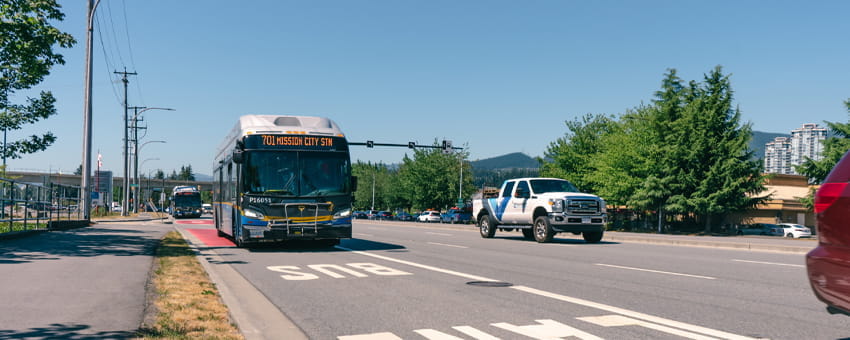 Bus lane at Lougheed Highway
Bus lane at Lougheed Highway
Although sometimes they may appear "empty" they are actually paving the way for a more efficient transportation network.
Queue Jumps
Queue jumps lanes are short, dedicated transit lanes (similar to approach lanes) or shared turn pockets paired with transit signal priority that allow transit vehicles to bypass traffic at an intersection.
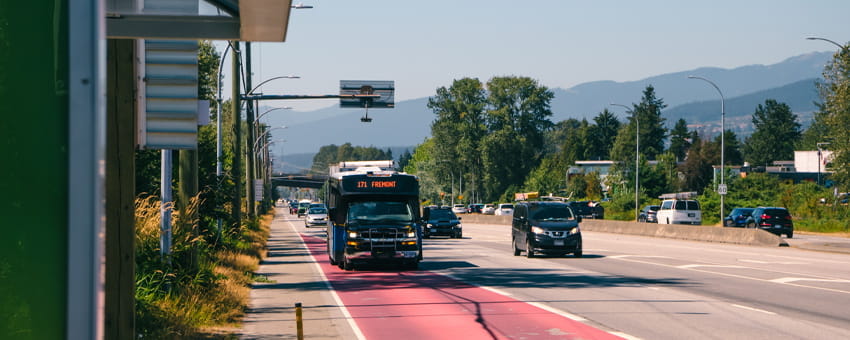 Queue jump on Lougheed Highway
Queue jump on Lougheed Highway
Turn Restrictions
Turn restrictions limit left or right turns for general traffic to reduce delay for buses and other vehicles travelling along a corridor. Buses may be exempted from the restrictions.
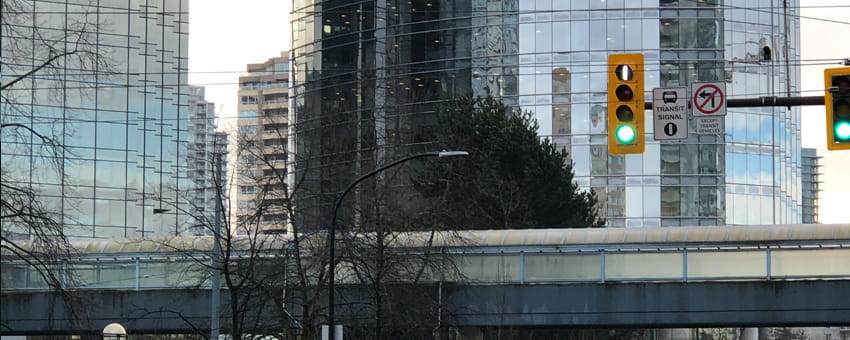 Turn restriction at Metrotown
Turn restriction at Metrotown
Signal Priority
Signal priority helps buses get through intersections faster by slightly extending a green light or shortening a red light when a bus is approaching. It is especially useful at busy intersections and pairs well with other measures like queue jumps and bus lanes.
